Ale & Hilary - Active Pass To Mayne Island
Saturday, February 07, 2009
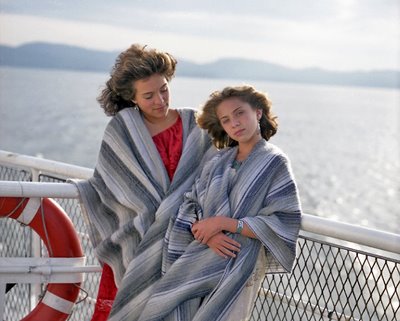
I have written before in this blog on how it is becoming increasingly more difficult for me to have my family make my granddaughters available for photography.
Rosemary and I filed our family pictures beginning with January 2009 and we went as far back as 2001. From then on the pictures, transparencies and negatives are not as well organized. I find pictures but not the negatives and the other way around, too. Eventually all will be organized. Today I happened to find this picture. I took it in 1986 the ferry to Mayne Island. It is near Active Pass.
In 1986 I was riding the crest of the business and city magazine wave. I was making lots of money. I decided to hire artist Jim McKenzie to paint my daughters. Because McKenzie uses a camera first to make his hyper realistic paintings we needed to give him access to Ale and Hilary. At the time McKenzie was well known for his ferry paintings. He now calls himself a West Coast Realist.
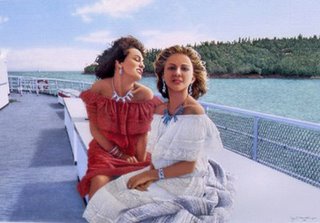
I asked him to photograph them on board. While he was at it I took my own pictures. This one is one of my favourites. In the third picture which I took at the Heffel Gallery on Granville you can see some more McKenzie. The striking woman is not part of the picture. Rosalin Te Omra worked at the gallery (and still does). I positioned her in such a way so that she is part of the painting which had attracted me in the beginning to hire the McKenzie.
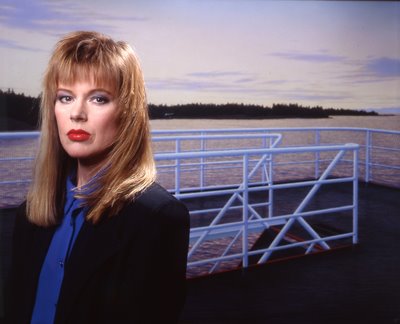
Thinking about the picture, it has ocurred to me that when I photograph Rebecca and Lauren I have had at least 19 years of experience learning how to do it with their mother and aunt!
Now if there were only a new surge in magazine work I would call McKenzie and put Rebecca and Lauren on the ferry to Mayne Island, via Active Pass!
Romance In The BC Ferries
Focus In The Darkroom
Friday, February 06, 2009

Photographer W. Eugene Smith's idea of a good time was to retreat to his messy darkroom with cigarettes, a bottle of Scotch, good music and a negative to work on.
I began my darkroom activities in 1962 when my artist friend, Robert Hijar, who was getting a fine arts degree at the University of the Americas told me, "I have access to the darkroom. I can teach you to process negatives and to print. But we will have to use the darkroom when nobody else uses it." That time was between midnight and the early hours of the morning. I would arrive all tired at home at 5 in the morning and crash to bed. The funny thing is that even though I was 20 years old my mother did not believe I had been working in a darkroom. She invented all kinds of tawdry affairs of which I was most unlikely to have had.

In that darkroom I learned to process film and print it under adverse conditions. The tap water was extremely cold as was the darkroom. The walls of crumbling dusty bricks were painted white and the second class "Toluca Rocket" bus would rumble past and vibrate the enlarger and ruin my prints. The Rocket had 15 or more forward gears. As it passed by on the steep curve the bus would gear down up. But all these adverse conditions were more than compensated by the good company of my friend and his state-of-the-art reel to reel tape recorder (courtesy of his parents who were CIA agents). We listened mostly to what was then called West Coast Jazz. Our favorite was a Stan Getz album called Focus which featured music composed and arranged by Eddie Sauter.
When I eventually had my own darkroom I still worked late nights (and for many years smoked a pipe until one day I got extremely dizzy and quit) but I chose not to play too much music. I loved the noise of the running water washing my prints and the electric sounds of my Charles Beseler enlarger's colour head. It was in the darkroom where I honed my printing style and learned to manipulate negatives which were far from perfect. It was in the darkroom where I learned the futility of cropping negatives under an enlarger and going for the more efficient and elegant method of cropping with my eyes, in camera.
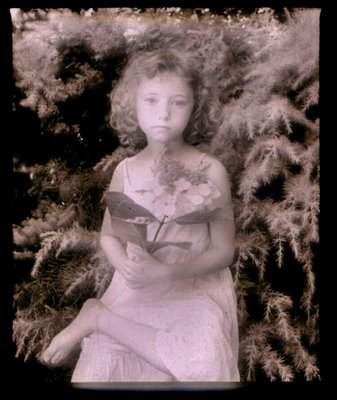
Nobody in my family has wanted to follow me into the darkroom. Rebecca flees the moment she smells the fixer. She says it will cause her problems. I do not tell her that I have used selenium toner for about 40 years and that it is supposed to be a carcinogen.
In the last few years my loneliness in the darkroom has been compounded by a lonely darkroom that rarely sees me. While I process the b+w film that I still happily shoot, more often than not I scan the negative to put an image in this blog or send bigger files to magazines, law firms and other companies that hire me.
Fiddling with a negative on my scanner while I look into the garden is pleasant. It is not dark and I even play Stan Getz's Focus in the stereo set behind me as my computer and scanner are on a Edwardian desk in the living room.

On a day like today, a day in which I have plenty of time to fiddle or as my grandmother used to say: Cuando el diablo no tiene nada que hacer con el rabo espanta moscas, which translates to: when the devil has nothing to do he swats flies with his tail, I spend working with the scanner. It is relaxing and fun. I began with a stark negative of Rebecca which I took in 2004 with Kodak Technical Pan Film in the 120 format. This film is the sharpest film ever made by anybody and it has an extended range into red. The film blocks blue and accepts more red. This means that skin blemishes (mostly red) appear lighter or disappear. The result is almost ghostly.
The first image here is the negative scanned more or less as is. In the second one I placed the negative on my scanner and then I covered it with a sheet of white paper. I scanned the negative from below. The scanner gets a bit of the texture of paper. The result is still a negative which when I reverse I get what you see here. The colour I can add in whatever direction I want be it cool or war. In the third image I "corrected" for the opacity of the paper and made it less hazy. In the fourth image I still used the paper but I closed the scanner lid and scanned the negative simultaneously from both sides.
Longing Is Not Nostalgia But It Is As Sweet
Thursday, February 05, 2009
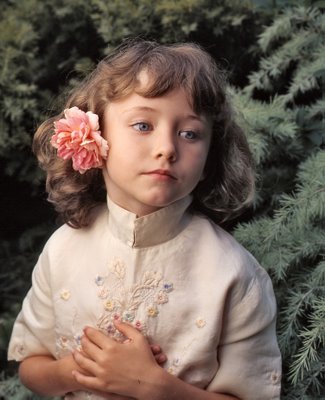
A boat, beneath a sunny sky,
Lingering onward dreamily
In an evening of July -
Children three that nestle near,
Eager eye and willing ear,
Pleased a simple tale to hear -
Long has paled that sunny sky:
Echoes fade and memories die:
Autumn frosts have slain July.
She still haunts me, phantomwise,
Alice moving under skies
Never seen by waking eyes.
Children yet, the tale to hear,
Eager eye and willing ear,
Lovingly shall nestle near.
In Wonderland they lie,
Dreaming as the days go by,
Dreaming as the summers die: 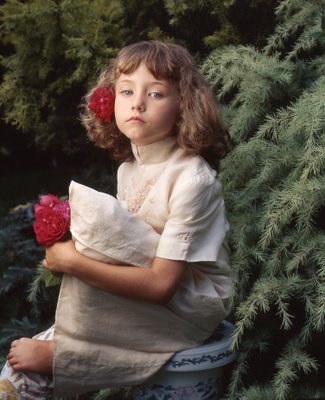
Ever
drifting down the stream -
Lingering in the golden gleam -
Life, what is it but a dream?
Lewis Carol, Epilogue to Through the Looking-Glass
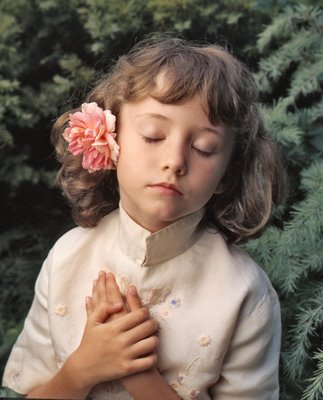
Of late I have felt a nostalgia for a hot Buenos Aires midnight at Pizzeria Burgio on Cabildo Avenue. Four years ago in November, Rosemary, Rebecca and I sat at a table on the sidewalk. I ordered a pizza, cokes for the girls and an ice-cold moscato for myself. Rebecca was curious and had a sip. Moscato tastes like very good sweet grape juice, but it isn't! Rebecca loved it. I told her, "Don't tell your other grandmother. She might not approve."
I discern a difference between nostalgia and a longing. I long for spring with the roses in bloom and their crisp aroma. I long for taking pictures of Rebecca and of Lauren as they walk barefoot on the lawn. I can smell it and imagine their delight in the coolness of the grass as its moisture slips between their toes.
The Dinoscopus & John M. Straney
Wednesday, February 04, 2009

In 1967 I went to Mass in Mexico City. I had not attended Mass for some years except in Buenos Aires. To my amazement, at a point during the Mass, perfect strangers on either side of me began to hug me. I could not understand what was happening. It seems that the liturgy reforms of the Vatican Council II (1962-1965) presided by Pope John XIII and Pope Paul VI had somehow passed me by! The other funny thing is that the priest faced us at all times. The mystery of what he had previously done with his back to us was now revealed. A few months later I heard that the church had held a most unusual Mariachi Mass.
Bishop Richard Williamson, of the Society of St Pius X (Fraternitas Sacerdotalis Sancti Pii X, FSSPX) is alive and well and living in Argentina. As a matter of fact he is the head of the Seminario de Nuestra Señora Corredentora (co-redeemer in Spanish) in the outskirts of Buenos Aires in La Reja, Moreno. This seminary is one of many worldwide run by the extremely conservative Society of Saint Pius X. It's South American branch can be found here. There is another rather handsome site here.
There has been a messy uproar of late when the German pope decided to revoke the excomunication of four Bishops (one of them is Williamson) who had originally been consecrated by the ultra-conservative French Archbishop Marcel Lefebvre. Few of the articles on the formerly Enlish and Anglican, but now most Roman Catholic Richard Williamson mention that he is alive and well in Argentina. They find it more important to inform us that this man regards The Sound of Music as satanic, on the grounds that Maria undermined Captain von Trapp's paternal authority.

That fine venerable and orthodox Argentine newspaper La Nación adds an interesting tidbit of Williamson lore. It seems that the young seminarians at La Reja (far shorter than Seminario de Nuestra Señora Corredentora), have to write with fountain pens and are not allowed to watch television. But the conservative Bishop does embrace technology when it is convenient. As a matter of fact La Nación reveals that Williamson has a blog called Dinoscopus and has managed to post 88 times in almost three years. Williamson's cartoon, below left, is from his blog.
I would like to interject here that while Bishop Williamson and I have our differences there are a few points in common. I have blogged not almost three years but a few days more. We are alike in not wanting creeps and idiots to contribute to our blogs so we do not allow comments. We both have ties to the lefebvristas which is how Argentines call ultra conservative Catholics. Williamson's followers are most certainly lefevbristas and I have a grand nephew, a member of the Opus Dei whose father says, "My son is to the right of Lefebvre." Since my grand nephew's father takes things lightly ( en joda, as they would say in Argentina) I am not sure if I believe him. He did tell me that his son had invited him to an old-time Mass with incense. He declined saying to his son, "I hate the smell of incense and besides I don't want to spend a whole Mass watching the priest's rear end."

The whole Bishop Williamson brouhaha brings to mind how my wise brothers/teachers of the Congregation of the Holy Cross handled with aplomb a situation that seems almost unreal and funny to me now when I think of it. At St. Ed's High School in Austin, I had a very good friend the first year I was there (1957) when I was in grade 9. His name was John Straney. He had also lived in Mexico and spoke excellent Spanish. In a neighbouring Texas scrub we had built a fort and we played there. We talked about the Nazis and their wonderful tanks and airplanes. We marveled at their cool uniforms. We discussed all the variant models of the Meschersmitt Me-109. One day later in the year he lost interest and never wanted to return to the fort. I did not understand that Straney was growing up faster than I was. For the next three years our relationship cooled and he moved to the more sophisticated circle of a Lee (Buddy)Lytton and John McShane.
It was in his 11th grade that Straney began to publicly assert his belief in the non existence of God. In a Catholic boarding school that can be pretty serious. I remember having various arguments with Straney where I applied every "proof" I knew for the existence of God. I told him of Aristotle's Unmoved Mover to no avail. Straney would not budge. I finally just gave up. But it is only now that I realize that the Brothers of the Holy Cross wisely never took him to task. They did not expell him. They kept their cool. Straney finally guarded his belief to himself. We all graduated in harmony. I have since found out from Lee Lytton that Straney was one of the earliest of our class to die. It is my hope that Straney led a useful and happy life. God or no God I am sure Straney would have happily accompanied me to my favourite church in Mexico City that featured Gregorian Chant. Straney would have admired and enjoyed the juxtaposition of modern architecture with an ancient rite.
Tuesday, February 03, 2009
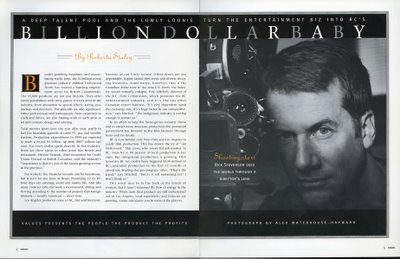 This morning I walked on the "Cambied" area of Granville Street, between Drake and West Georgia. I entered Leo's Camera Supply and thought about a column, written by Pete McMartin, that I had read earlier in the Vancouver Sun. It was about Granville Street, but further south by 16th Avenue. Pete McMartin wrote a passionate protest against the B.C. Supreme Court Justice Sunni Stromberg-Stein's ruling that Falung Gong must remove a shack and a row of billboards the group has maintained in front of the Chinese consulate since 2001. Mr. Mc Martin wrote:
Now I would not dare to fault the judge's decision. She was just doing her job and interpreting the law as she saw it. But what do I find fault with?
Here, in the city of Bob Hunter and Greenpeace, of Harry Rankin, of the country's most vibrant social activism, there has been a disturbing silence. The most disturbing silence of all can be found at city hall... As it has increasingly become more difficult for me to find my way to one of my two favourite camera supply stores in town, (the other is Beau Photo on 6th and Granville) because of constant construction and blocking of streets I have thought that my difficulty is nothing compared to the problem of running a camera supply store in the 21st century with the added injury of curtailed access. Vancouver is blessed in having several photo labs. Those legions who shoot digital and do not need film to be processed might explore the beautiful light jet prints (only available in these labs) that can transform a digital file into a work of art. Vancouver is blessed in having several photo stores that compete with the best that New York has to offer. These are Leo' and Beau Photo. Leo's in particular has that smell, an exciting smell that comes from the metal of some of those film cameras that were indeed made of metal and not of policarbonates It is a smell that an oldie like me would say is the smell of a real camera store. What makes these stores a Vancouver treasure is that they stock stuff that you would have to look at length to find on line. Walking into Leo's you see state-of-the-art Canons (the ones you need car loans to buy) but you also see Leicas and beefy dangerous looking motor driven Nikon F3s. The young men who work at Leo's know their stuff and some more. What do you need to pack in your camera bag to take pictures at Machu Picchu? Ask David Donaldson. Peter Foweraker will tell you the subtle differences in using developer HC-110 in Dilution B or C and throw a really good used camera bag in the bargain. If your DSLR card is noted as corrupted on you computer, after your trip back from the Antarctic, you can bet that Chris Screech will somehow retrieve those valuable pictures. But it is Jeff Jin whom I usually consult the most. He will explain that the LCD's of a flat screen monitor glow when they are turned off so that it is difficult to get a real black with some of them. You are having problems with your PC's mating with Photoshop? Jin who is an expert with his Mac will not tell you how sorry (and stupid you are) in that you don't also have a Mac, but will actually help you solve the problem. For years I have more or less had a successful photographic business. I always like to point out that the necessary ingredient for success in Vancouver is a good support staff. You need a good repairman ( Horst Wenzel), someone to keep your flashes going (Viktor) a good lab (George King, The Lab, ABC Photocolour) a good drum scanner and giclée printer (that's Grant Simmons at DISC). And of course a good store. Besides Leo's and Beau Photo I have found stuff at Lens and Shutter and used bargains at Kerrisdale Camera Supply. I am sure that you might just get that DSLR you want cheaper by mail order or by going to the Future Shop. But it is a Leo's where they will patiently tell you how it works. They are part of that necessary support staff. To keep these treasures in Vancouver thriving one has to do business with them. Instead of clicking on that computer I would rather hop on my B-Line Bus and go to Leo's or to be wowed by the incredible variety of film stock at Beau. I like to linger, talk to the boys (there are girls at Beau, too!) and perhaps run into photographers that I know. In 1999 I had a sweet job to take pictures for a magazine published by the BC Central Credit Union. The art director, Chris Dahl insisted I photograph one of my subjects, a film director, with a movie camera. That seemed easy. It wasn't. It was a busy film weekend. I could not find a camera at Panavision. Nobody would rent me an Arriflex. In desperation I went to Leo's. I asked Jef Lin, "Can you help?" He answered, "We have three. Which model do you want?" I left minutes later with a beautiful Arriflex (seen in the picture above with director Rick Stevenson. Incredibly, Gin took a chance and I walked with the simple signing of a paper. When you do business with good people the trust is mutual. Returning to the Pete McMartin column he writes about Bob Hunter and Harry Rankin. He is absolutely right. But I think that if McMartin went out to the street he would be hard-pressed to find anyone who would know who those fine and dead gentleman were. That is our tragedy. In Vancouver we not only miss that which we no longer have but we sometimes compound it by forgetting we had it at all.
Robert Altman - A Cornet & A Bb Clarinet
Monday, February 02, 2009
 My concept of music and sound was just about like everybody else's until sometime around 1959 when Brother Edwin Reggio CSC looked at me straight in the face and said, "I need an alto saxophone player for the school band and you are going to be it." Even though he was not taller that I was, he was strongly built and I felt I could not refuse the man. I was never anything more than an efficient player. I could get a very sweet and mellow sound from my instrument but I compensated adversely by not reading music well. I was good enough not only to play for the school band but also for the special swing band. I learned to watch Brother Edwin's short, but well toned arms as he directed us in playing such classics as Sweet Lorraine, Stars and Stripes Forever and Cherry Pink And Apple Blossom White. With the swing band we played stuff like Basin Street Blues and Dixieland tunes that pushed my musical reading limits. One day I asked Brother Edwin the difference between a cornet and a trumpet. His answer was short and strange, "A cornet blends better with a Bb clarinet." I have long since determined that Brother Edwin was absolutely right." That small musical lesson inspired me to listen to the sounds of different instruments and to discern the differences. In the evenings in our 10th grade dormitory (about 40 students in bunkbeds in a dormitory so Gothic and high that in wet weather I swore I could see clouds drifting into it) our prefect, Brother Rene Lenhard played his favourite classical records. My personal favourite was Ravel's Bolero because almost each instrument (particularly that wonderful trombone)had a solo. It was my "Young Person's Guide to the Orchestra" before I knew the existence of Benjamin Britten or Henry Purcell. My interest in playing the alto saxophone faded as soon as I left the school. But my rudimentary knowledge of the instrument made me appreciate the tones of such jazz players as Paul Desmond, Stan Getz, Gerry Mulligan, Ben Webster, Lester Young and Zoot Sims. I tried to get clear sounds out of the oboes and clarinets of my fellow band members. I could not. I learned to respect those who play these difficult instruments. I sailed smoothly from mono to stereo and bypassed quadraphonic recordings. I suffered with the wow and cassettes. By 1970 most of my high school students in Mexico City had heard that my mother was deaf and that somehow she had taught me to lip read. The rumours flew in the school. The truth is that I had developed not only a keen ear for sounds, even from subdued conversations from the last rows of my classroom, but also an ability (one that I retain to this day) of being able to listen to several conversations at the same time. At about this time I switched from enjoying cowboy, pirate and war movies to the sexier European films of Antonioni and other Italian masters. I remember when Rosemary and I saw the 2001 - The Space Odyssey around 1969 in a brand new Mexico City theatre that had advanced sound. It was exhilerating. It was also at this time that I noticed some advances in how sound was used in films. You would as an example watch a nomad on a camel transversing the side of a sand dune when suddenly you could hear the sounds of a piano. In what seemed a long moment of time the scene would change to an exotic Cairo bar and focus on the hands of a pianist. I found this technique interesting and I liked that it was non-linear. But I was still shocked sometime in the late 70s when I saw Robert Altman's Nashville. The sound was revolutionary. The sound was like the different simultaneous conversations of my students in class back in Mexico City. At first I thought this director, this Robert Altman (I had never heard of him before) was nuts. Then I began to appreciate that, at long last, someone was recording conversation as it truly happens. Since Nashville I have seen most of his films and I particularly enjoyed watching The Company (2003) with Rebecca a couple of years back. Any film that has a backstage, a stage and an audience (this film was about the Joffrey Ballet) is Altman territory with all those simultaneous conversations behind and in front of the curtain. Tonight, without knowing that it was an Altman film (but I caught on in minutes) Rosemary and I saw most of his last film, the 2006 A Prarie Home Companion. It has that stage, that back stage, that audience, a recently dead man and a white trenchcoat woman with a double role, she plays an angel and the angel of death. There was no cornet or clarinet in sight but I appreciate to this day Brother Edwin's lesson. He taught me not only the value of sound but to appreciate its importance in the making of a good film. In the picture above, taken by Brother Edwin with his Konica in 1960, that's me, top left.
Bank of British Columbia - Lost & Found
Sunday, February 01, 2009
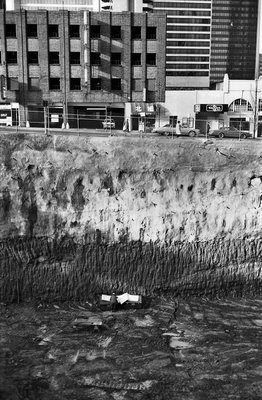 I took this photograph in 1984. While in my youth (in the 60s ) I would have never been caught going anywhere without a camera, by the 80s I only had one with me when when working for a paying magazine or corporate job. Through the years I have attempted to hang a little camera around my neck and take pictures wherever I go. I get ambitious and then frustrated thinking that I should have brought a tripod, or another lens, or colour film, etc. Within days my determination to have a camera with me falters and that's it.
Around 1980 I obtained a good deal on a Minolta camera that could accomodate Leica thread lenses. My Minolta CLE came with a wide angle, a normal lens and a telephoto. For a while I went everywhere with it. When I saw this hole (the corner of West Georgia with Howe I snapped a few. In retrospect I should have had the camera on a tripod as the picture is slightly fuzzy.
The hole became the Bank of British Columbia and its last director was Edgar Kaiser Jr. The bank folded and was taken over by the Hong Kong Bank.
Yesterday while going through the Stephen Drake files (for yesterday's blog) I found an envelope that did not belong there. It said:
Bank of Hong Kong
Hong Kong Bank
Construction hole
Every time I think of this bank and of the Hotel Vancouver (or is it the Vancouver Hotel?) I have the problem. That is why the envelope had both names. I had lost the two negatives around 1990. Losing any of my pictures is painful. I am glad to have found them. Notice on the top right the name of the bar, Bradley's. It was run by Gary Taylor. It was a place that I haunted for some years.
|





















